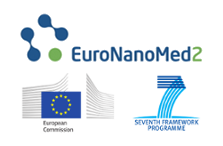About
Project objectives
The main objective of the INNOCENT project is to develop a novel nanoparticle-based therapeutical strategy to overcome low efficacy and frequent relapses in breast cancer treatment with particular emphasis on cancer stem cells. Using the multifunctional nanostructure, we will investigate whether the co-encapsulation of multiple therapeutic agents along with gene therapy and inorganic nanocrystals into one nanostructure, will reduce the proportion of cancer stem cells and inhibit cancer cell growth. In vivo testing will be used to determine if encapsulating will increase efficacy and specificity against cancer cells, especially cancer stem cells, preventing unwanted side effects.
In order to achieve these goals, we have set the following five project objectives:
- To develop organic nanocarriers and inorganic nanocrystals for therapeutic purposes
- To develop a multimodal COMBOBOMB prototype by co-encapsulation of therapeutic agents and inorganic nanocrystals into nanocarrier
- To use ‘safe by design’ approach to select the most efficient and safe COMBOBOMB prototype
- To monitor the distribution, accumulation and efficacy of the most safe COMBOBOMB prototypes
- To provide experimental proof-of-concept using omics approaches
Project structure
The INNOCENT project is divided into seven work packages, covering the scientific and technical aspects of the project, exploitation and dissemination of results, ethic requirements and project management.
WP1. Synthesis of nanocarrier
This WP is devoted to the synthesis and characterization of organic nanomaterials (for targeted delivery of therapeutic agents and plasmid) and inorganic nanocrystals (for MRI imaging and therapy).
WP2. Detailed characterisation of synthesized nanomaterial
The results obtained in this WP will allow us to assess the putative effects of physico-chemical properties on key biological processes.
WP3 Safe by design: Hazard and risk assessment of the nanocarrier
The toxic potential of the novel multimodal nanodrug will be investigated at all development stages, through an integrated approach.
W4 Drug treatment in vitro
We will study the efficiency of single as well as combined targeted treatment on non-adherent 3D cultures. Mutual cooperation chemotherapy, epigenetic treatment and gene therapy will be assessed.
WP5 Drug treatment in vivo
Efficacy of targeted therapy will be evaluated on orthotopic as well as metastatic in vivo model at cellular and molecular level.
WP6 OMICS - Expression, Epigenome, Processing, Data analysis
OMICS analyses will be applied to confirm that combined demethylation therapy is sufficient to reverse hypermethylation-induced gene silencing of tumour suppressor and other cancer-related genes.
WP7. Consortium management, communication, decision making, data processing, and dissemination
Each work package will be managed by a work package leader who will be responsible for the timely delivery of deliverables to the Coordinator, who in turn represents the Consortium to the Commission.

